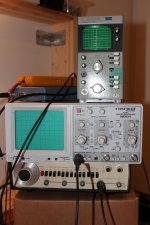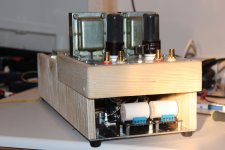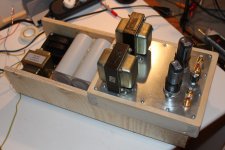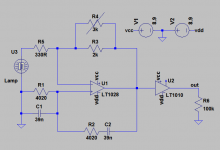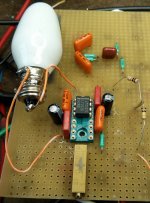For those of you interested in testing your amplifiers, I built a version of this oscillator
Injection-lock a Wien-bridge oscillator | EDN
and got it to measure distortion of about 0.0006% (-104dB) at about 5V RMS output. Why this is significant? Because you will pay big $$ for a signal generator that has such output at such low distortion, but it'll cost very little to build the circuit in the above link. The problem with a sound card like the E-MU 0404 used to generate the signal is that as soon as you want a signal higher than about 300mV RMS you'll notice that the distortion of the generated signal is quite high.
In my opinion this little oscillator is good enough for testing tube gear. If people are interested I can post construction and parts choice details (which opamp, which light bulb, which buffer for output, etc.).
Thank you. I will do that. I noticed that there were many options on the bay for modules, but was unsure about the quality.
Buzz, look for a Leader LAG120B (pls note B), they are cheap and worth every penny. Discard LAG120A, not as good.
An example: Leader Lag 120 Audio Frequency Generator Test Stereo Amplifier | eBay
If you're lucky, you may also find a LAG126 or if you have some spare money, buy an Audio Tester 192A, same sig gen and a nice dual ch analogue RMS voltmeter with double needle for almost free 😉
Thanks Massimo.
Cool. Lower left corner is a common one on my scoopings, but according to the pic the upper right one, rounded in all corners is better? Phase shift, what does that mean, what happens in the amp and why?
Btw I was at a friend last night and exchanged a bag of beer for one of his 5 scopes (or two actually) so now I possibly have something to relate the other measures to. Came home a bit late and a bit unsteady on hand so I skipped the HV fiddle.
Its for when you are challenging the amp's bandwidth edge and the phase turn is steep also. Say not 6dB but a 24dB slope. You generally don't see HF problems when you are using a 20-10 times less frequency square wave than what the amp can do for HF bandwidth. With the middle left example you are also familiar, it is when you are under 150-100Hz and the response is flat but your ac couplings and the OPT are already shifting the phase. Interesting what beer can lend in the land of Thor.😀

Interesting what beer can lend in the land of Thor.😀
Indeed. And another one for a pack of smokes.😀
Attachments
The Pico must read some noice from the diffprobe. I wonder if a thing like this could make it usable?
100MHz Oscilloscope High Voltage Clip Passive Probe, X100, Max. 2000VDC: Amazon.com: Industrial & Scientific
Pico is 20V, it can give you 200V DC+AC pk with a x10. x100 is good for voltage but cuts 40dB SNR. Not good for small amplitude wiggles or noise hunting. CAT I is not for direct to mains. You try choose 50% to 100% faster probe than your scope as a rule of thumb. The probe is fast only at x10 mode. It can be 6-10MHZ at x1 but best for SNR when chasing ripples. The probe holds its x10 or x100 DC voltage spec only up to 20-30kHz then it progressively loses impedance and voltage spec. There is usually a voltage VS frequency chart in its spec sheet. Use same type and spec probes when comparing signals utilizing both channels or doing XY tricks. You get two x10 of those for same price on Ebay. Choose HK dealer if you want to get them before summer.😀
Here's the circuit I implemented, with the following notes:
* for U1 I've tried a few opamps: AD8597, LT1028, OP07, OP27, AD797. The lowest distortion was achieved with the AD797, AD8597, and LT1028. The difference between these three was not significant to me.
* for U2, the buffer, I actually use BUF634
* R1 and R2 should be measured to be as close as possible, and similarly C1 and C2. They determine the frequency of oscillation
f = 1 / (2 * pi * R1 * C1)
In my case this amounts to something around 1016 hertz.
* the lamp I used is a 120V/7W night light bulb which I got in a dollar store (5 for 1$). It measures 200 ohms at room temperature.
* R4 is a trimmer, and in parallel with R3; the parallel value of the two after some tweaking is about 1K1, or about twice that of R5 + Rlamp.
I powered it from two 9V batteries. The circuit takes about 15-20 seconds to stabilize. The lowest distortion I measured was around -104dB, or about 0.0006%, comprised only of H2 and H3.
Edit: I added a photo of my work in progress. In the upper right there's a notch filter too. I'm toying with the idea of also adding a number of R,C values to have a few different frequencies to choose from.
* for U1 I've tried a few opamps: AD8597, LT1028, OP07, OP27, AD797. The lowest distortion was achieved with the AD797, AD8597, and LT1028. The difference between these three was not significant to me.
* for U2, the buffer, I actually use BUF634
* R1 and R2 should be measured to be as close as possible, and similarly C1 and C2. They determine the frequency of oscillation
f = 1 / (2 * pi * R1 * C1)
In my case this amounts to something around 1016 hertz.
* the lamp I used is a 120V/7W night light bulb which I got in a dollar store (5 for 1$). It measures 200 ohms at room temperature.
* R4 is a trimmer, and in parallel with R3; the parallel value of the two after some tweaking is about 1K1, or about twice that of R5 + Rlamp.
I powered it from two 9V batteries. The circuit takes about 15-20 seconds to stabilize. The lowest distortion I measured was around -104dB, or about 0.0006%, comprised only of H2 and H3.
Edit: I added a photo of my work in progress. In the upper right there's a notch filter too. I'm toying with the idea of also adding a number of R,C values to have a few different frequencies to choose from.
Attachments
Last edited:
Max output voltage peak to peak seems can be close to the supply rail. I set mine to something around 14V peak to peak. That's the part that beats the sound card solution. Generators that can give such high p-p value at low thd are very few. And to test a power buffer or a tube power amp it's good to have some higher Vpp.
Edit: sorry, I should say that MY E-MU 0404 is not capable of a low THD high Vpp output. Maybe some other cards can do that.
Edit: sorry, I should say that MY E-MU 0404 is not capable of a low THD high Vpp output. Maybe some other cards can do that.
But on what you FFT that Vpp at 24bit for excellent SNR if it is not a pro benchtop analyzer?
I measured it at full Vpp with my HP 3585A spectrum analyzer (with the notch filter). And I measured it with a resistor divider 1/10 with the 0404. In the low distortion audio range oscillator thread Scott measured his implementation of this circuit (AD797) and his result was even lower distortion than mine. And he has better equipment, I would think. 🙂
Can't think of any. The measurement seemed to confirm that. But anyway, the output of a preamp must be attenuated before feeding it to any sound card. Unless you test a preamp with signal in the order of mV, but then, that's unrealistic. The distortion will be very low for such low input. A more real test is to give the preamp 1-2V RMS. The distortion will, of course, be higher. It's good to have a generator that can give such signal at low thd.
The added Johnson is only what I can think of (moot for high level signals). Also not for driving 50 Ohm instrumentation transmission line in the MHZ.
Yes, definitely the resistor added noise is no problem, good point. I'm thinking that the divider can be added before the buffer, to keep the low output impedance.
In any case, I was extremely surprised to get such results from this classic solution, I thought I'd share since the other fellow mentioned generators.
In any case, I was extremely surprised to get such results from this classic solution, I thought I'd share since the other fellow mentioned generators.
You should get no other measures than a logically high output resistor (much higher than the amps you gonna drive) if your measurements are confirming OK response and squares after revisiting the procedures in good control.
Back to an old post about output leak. If i have a 470k on my next stage, what would be my choice of leak on pre then?
- Home
- Amplifiers
- Tubes / Valves
- 6V6 line preamp
